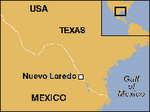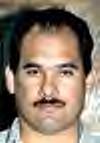U.S.- inspired militarization of drug war seen as growing security threat...
By Frank Levine
Hispanic Universal/InterPress
This story was originally published by Hispanic Universal and posted in February, 2007. It will be followed by a story on the Mexican oil industry and the growing number of attacks on it by Mexican revolutionary forces.
AUSTIN, Texas--The stench of death rises above the Rio Grande, chilling the social and political landscape from Mexico City to Washington.
It comes from a horrific bloodbath between rival drug gangs and their “partners in crime”-- elements within Mexico’s local, state and federal governments –all fighting to control billions of dollars generated by the massive illegal international drug trade.
The slaughter has claimed over 2,000 lives in the past year, and nearly 200 in January alone, including law enforcement officials, priests, journalists, army soldiers, politicians, popular singers, actors, cartel soldiers and scores of innocents. Hundreds are simply “missing,” their bleached bones, strewn from the Guatemalan border to Tucson, San Antonio and beyond.
Even as Colombia slid to the gates of Pablo Escobar’s hell in the 1980s, the drug connected death toll averaged about 3,500 annually, barely less than double that of Mexico’s current pace. And although the Mexican Government reports deaths seemed to diminish in late 2006, a series of horrific killings recently have propelled the rate to meet or exceed the 2006 toll.
In Mexico, as in Colombia, the rich and powerful die just as easily as the poor. Heads of policemen are found on rooftops and fences in Acapulco, dozens of tortured and charred bodies are found scattered in Nuevo Laredo and Juarez. Some victims are found in pieces strewn along the highways.
Last week, 12 men wearing army fatigues stormed two police stations near Acapulco, murdering seven police officers and two secretaries. They reportedly left a videotape behind, announcing that they “don’t give a s--- about the federal government…and this is our message.”
Both the mayor of Acapulco and the head of Mexico’s Tourism Department lamented the impact of such violence on tourism and business.
Acapulco Mayor Felix Salgado, who is surrounded by 12 body guards, 24 hours a day, believes his days are numbered and unless massive help arrives soon, all hell will break loose.
“The situation is out of control and the only way to stop the violence is with federal troops...but their presence here will only hurt tourism and the economy.”
Although the carnage also continues along the northern border – in the Monterrey area alone, 14 police officials have been murdered in recent months—Acapulco remains the focal point of some of the most horrific violence, as it straddles a vital drug route from Colombia to the Mexican Pacific Coast, where Colombian pure cocaine and heroin join Mexican heroin, marijuana and methamphetames on their final push into the U.S. market.
New president opens military offensive against cartels with mixed results...
In December, newly installed Mexican President Felipe Calderon deployed nearly 25,000 national police and soldiers to fight “narcoterrorism,” in the states of Guerrero, Baja California and Michoacan, among others; but so far there is little to show for his efforts other than piles of bodies, the extradition to the United States of a few alleged drug kingpins, and the continuing, if reserved, diplomatic, military and law enforcement support from the United States.
Calderon also allowed the extradition of the leader of the Gulf cartel, Osiel Cardenas Guillen. The move by Calderon was praised as “unprecedented” by U.S. Attorney General Alberto R. Gonzales, but it required that Calderon break a long-standing Mexican doctrine in the face of bitter political opposition. The move was finally made after Mexico’s Supreme Court ruled –apparently under considerable pressure—that extraditions of prisoners facing a life sentence in a foreign country, “was not cruel and unusual punishment.”
Last year Mexico extradited a record 63 suspects to the United States, many of whom were connected to the drug trade. But the greatest victory against the cartels came in August, when Francisco Javier Arellano-Felix, leader of the notorious Tijuana cartel was captured by the U.S. Coast Guard on the high seas off the coast of La Paz, Baja California. He awaits trial in San Diego on charges of racketeering, conspiracy to import drugs, and money laundering, among others. His brother Eduardo reportedly now runs a weakened family empire besieged by its cartel competitors and authorities.
As in Colombia, the cost of Mexico allowing such extraditions could be very high, creating a political backlash, and an extremely dangerous climate for courts and government officials, including the president.
Meanwhile, last week, Calderon received the traditional Mexican Army oath of loyalty in the annual “Army Day” ceremonies held in Tula. In grateful response, he increased the average soldier’s pay from $317 per month to $474 per month, but it will do little halt the influence of drug cartels on the military, especially when compared to the average $3,000 a week a drug cartel soldier earns shooting real and imagined enemies.
“The challenges the country faces today are enormous ... and for that reason, as supreme commander, I have ordered a redoubling of efforts in the job of protecting people and the nation," Calderon said. He then announced additional troop deployments to the states of Nuevo Leon and Tamaulipas, and promised increased interdiction efforts in the states of Guerrero, Durango, Sinaloa, Coahuila and Baja California—especially in the Tijuana area where there were reportedly 399 drug trafficking related murders last year.
Although the 160,000-strong Mexican Army has maintained much of its traditional honor and has remained somewhat aloof from the pervasive corruption of nearly every other government institution, there are numerous reports that the drug cartels are recruiting and corrupting elements within the Mexican armed forces, posing a serious security threat for the nation, and by extension, U.S. interests.
“It is in the interest of the United States and Mexican governments that the Mexican Army be vaccinated against narcoterrorism,” said one high-ranking Mexican official, who prefers not to be identified. “Unfortunately, we don’t have the resources to ensure complete loyalty within the military, as witnessed by the recruitment of soldiers and former soldiers into paramilitary groups; however, a livable wage paid to the average soldier is a good start, and should reduce some of the temptation.”
Mexican Army loses elite soldiers to cartels big bucks recruiting campaign
In recent weeks, U.S. officials released redacted intelligence assessments indicating that narco-corruption is spreading rapidly within the Mexican Army, and that new paramilitary groups like, “Los Negros” and “Los Numeros,” have also recruited members from the military, many of whom were once trained by their government and the U.S. to fight drug trafficking. These new groups are positioned to challenge the weakened Gulf cartel led by Guillen and his “Los Zetas”—a bloody assassination squad created in the late 1990s by former army special operations and intelligence veterans to control the Nuevo Laredo-Laredo smuggling routes, referred to as "plazas.”
The newest paramilitary groups, meanwhile, are reportedly working for the Sinaloa or Sanely cartel, headed by Joaquin “El Chapo” Guzman Loera, joining his group of paramilitary assassins, “Los Pelones.” Since his escape from prison in 2001, he has extended his organization's control of the Mexican cocaine market and is now locked in a death grip struggle with a weakened Gulf cartel for dominance along the border.
Meanwhile, the Juarez cartel, said to have once controlled more than 14 percent of the cocaine trade to the U.S., has fallen into disarray following the arrest of its financial wizard Ricardo Garcia Urquiza. The cartel’s weakness opened opportunities for competing cartels to grab larger shares of the profits and control more distribution points. “El Chapo,” was the first to challenge the Juarez cartel, and to begin wrestling control of the Nuevo Laredo plaza from the Gulf cartel, precipitating the latest violence there. The violence soon spread to Acapulco, as the battle over control extended from border distribution points to the points of procurement and entry.
Acapulco’s role has become a natural cocaine disembarkation point as it rests on a beeline north from Buenaventura, Colombia, were many of Colombia's drug trafficking organizations ship pure cocaine north through relatively un-patrolled waters, circumventing the heavily patrolled Caribbean areas. Speed boats pick up the drugs at sea, then transfer them to Acapulco, where they are loaded onto trucks destined for Nuevo Laredo and other crossings to the U.S.
Nuevo Laredo is just one of many entry points; but to dominate the market, control must also be established over the reception point—in this case, Acapulco. Unfortunately, the port is not big enough to handle the avarice of more than one cartel at a time.
Meanwhile, the greatest fear is that the cartels will continue to “paramilitarize,” further destabilizing the country’s political and social climate.
“Further paramilitarization….will propel the violence to a whole new level,” says Mexican drug expert Luis Astorga, a professor at Mexico’s National Autonomous University (UNAM) in Mexico City. “If this trend continues, Mexico will indeed be another Colombia at the doorstep of the United States.”
Ironically, it was the U.S. government in 1996 that cajoled the Mexican government into pushing the relatively uncorrupted Mexican Army into a central role in the war against drug trafficking. At the time, many senior Mexican Army officers protested that the army was ill-prepared to participate in what is essentially a police matter -- especially when it is confronting sporadic guerrilla activity in remote areas of the country. They worried that the temptation of billions of dollars passing through their country could be a corruptive influence upon soldiers—and they were right. Furthermore, they complained that the Mexican Army’s structure and lack of modern equipment, combined with insufficient transportation capabilities, made it difficult to deal with multiple rapid deployments over a wide area.
Even to the most optimistic observers, Mexico appears to looking more and more like Colombia – it emerging as a narco-state where political and military power is split between the drug cartels, a U.S.-backed government alienated from the masses, unrestrained paramilitary formations, and a mounting Leftist insurgency, portrayed as “narco-terrorists” by the U.S. and its dwindling number of hemispheric allies.
Unofficially, the Mexican government security reach extends far beyond its formal military and law enforcement formations; but it is focused primarily on gathering intelligence on political and criminal threats, rather than drug trafficking. Some experts estimate that the Mexican government’s combined paramilitary and military forces actually total more than 500,000; with about half that number described as “supportive paramilitary cadres,” often working secretly and independently as extrajudicial “muscle,” attached to local law enforcement units.
In opposition are an estimated 10,000 individuals described as active in the drug trade, with another 30,000 considered “amateurs.” Second and third tier participation boost the total to more than 100,000. Furthermore, there are millions who wink and nod—through popular music and word—at the lifestyle of the drug trafficker, undermining the government’s ability to gather intelligence against the cartels. Leftist guerrilla formations, meanwhile, reportedly total about 7,000 to 10,000 combatants in various levels of competence on all fronts; with an additional 40,000 to 60,000 described as “active non-combatant” supporters.
“It is ironic that the success of the Mexican Army against insurgencies during the 1970s and 80s was due in great part to its human intelligence capacity, and its ability to infiltrate and destroy radical groups from the inside,” says one former Mexican intelligence official. “If the people weren’t arrested, tortured, killed or disappeared, they were paid off to abandon their cause…The technique was extremely successful. Now, however, the cartels have too much wealth and power to be bought off so easily, and in many parts of the country the community, either tacitly supports the traffickers, or is afraid to get involved.
Although the government can report some recent success in the dismantling of two major cartels, the tables are being turned, as it is now the Army that is being infiltrated and compromised by very sophisticated drug traffickers and their highly trained and heavily armed paramilitary units.”
It is estimated that the Mexican cartels earn more than $50 billion a year, with a sizeable portion of the money used to purchase more cocaine and heroin from the Colombians, and weapons from the United States and the international market. The more than 7,000 weapons confiscated in 2005 from traffickers—most were traced back to the U.S. — have been described as “a drop in the bucket,” by one Texas law enforcement official.
Along the way, hundreds of millions of dollars are siphoned off to law enforcement officials, politicians, and anyone else potentially blocking the drug flow. Nearly 10 percent of revenues are reportedly used to pay off officials. If true, that means that possibly $5 billion a year is lining the pockets of corrupt officials—including elements within the army—on both sides of the border.
Little can be done to stop it, as many officials are offered the "plata o plomo," choice between money and cooperation, or a bullet to the brain.
New world order creates more disorder in Mexico...
Some researchers believe at least part of the growing social violence and the expanded role of the illegal drug trade is due, in no small part, to the economic and social fallout of the North American Free Trade Agreement (NAFTA) and its overall negative impact on Mexico’s socioeconomic fabric—especially in rural areas where compesino farmers and small collective farms simply can not compete against international agro-corporations.
Mexico’s slide into chaos is but the latest chapter in a long and sangrienta chronicle that erupts at least once every century.
Where once there was class warfare, cynical exploitation, greed, and competing ideological visions, there remains now little more than greed and exploitation, revitalized, in part, by a neoliberal ideology that defines the poor masses as somehow deserving of their fate.
Mexico’s internal strife differs only in scale from the pre-revolutionary era, having burgeoned in direct proportion to the country’s population. In some ways, few of the underlying factors have changed, as there remains a pressured middle class, predatory foreign capital investments, urban youth seeking expression, working class and rural poor in spasmodic anti-government violence, intellectuals dreaming of change, and a handful of guerrillas hurling their lives against walls of a powerful and corrupt system.
Mexico’s neoliberal economic and social agenda under successive Institutional Revolutionary Party (PRI) and National Action Party (PAN) presidencies, perceived the country’s masses only in terms of its exploitive potential for the benefit of a ruling oligarchy and its allied foreign interests.
This unrestrained entrepreneurial spirit in the pursuit of wealth and power, regardless of its impact on Mexican culture and humanity, only cheapens and alienates life. From the wanton pollution and destruction of the Mexican environment, to the pollution of the Mexican spirit, neoliberalism has given narco-violence, and for that matter, all violence, a fertile ground upon which to flourish.
“With so many desperate people, a dog-eat-dog mentality has placed many at odds with their government and themselves,” says Jacobo Sanchez Villareal, a small business owner in Nuevo Laredo. “Our traditional respect for human life has been undermined by a virulent media propaganda extolling the virtues of individualism over societal needs, profits over life, materialism over culture and humanity. Believe it or not, the drug traffickers –even if they are criminals and ruthless killers— are considered heroes by a very large segment of society, as they often share their wealth with the poor, while at the same time, challenging the corrupt and hypocritical governments on both sides of the border.”





